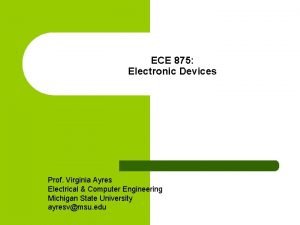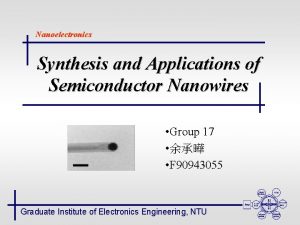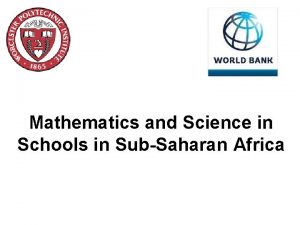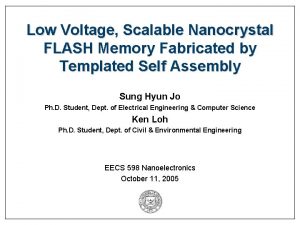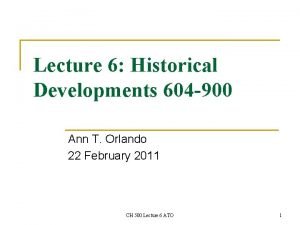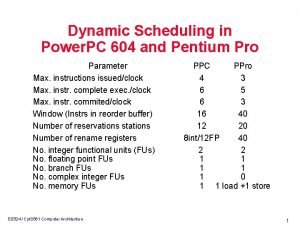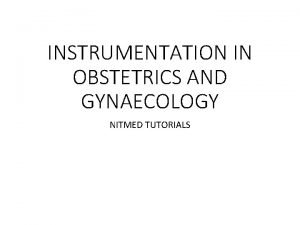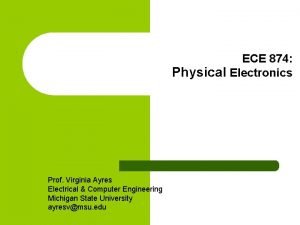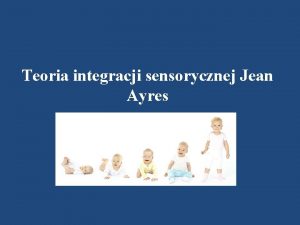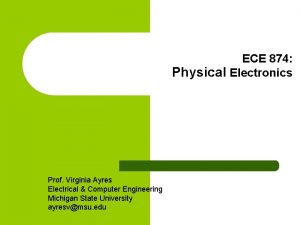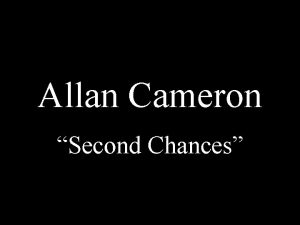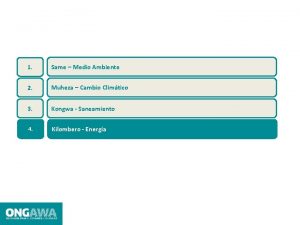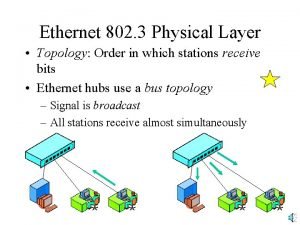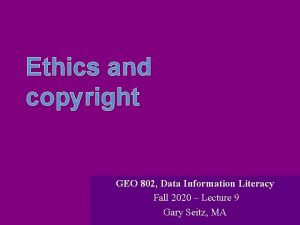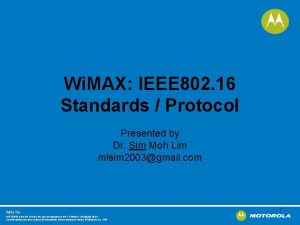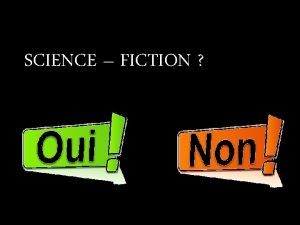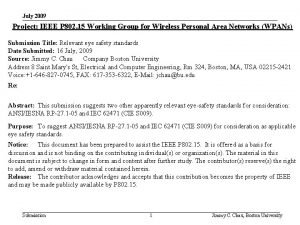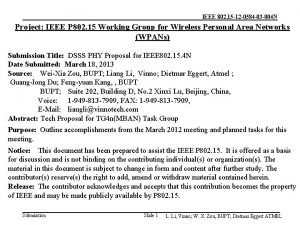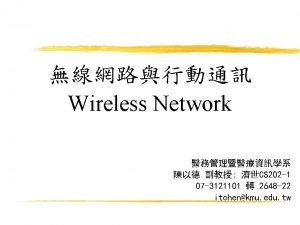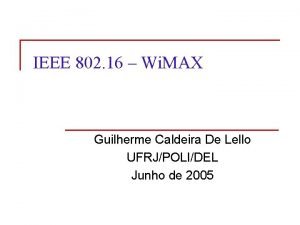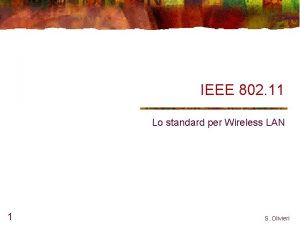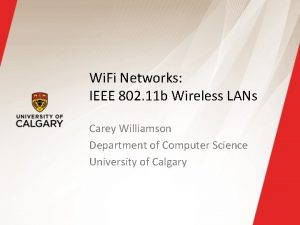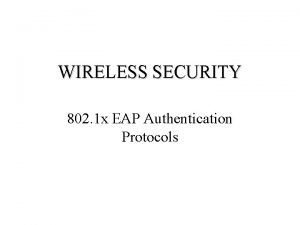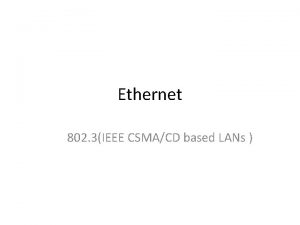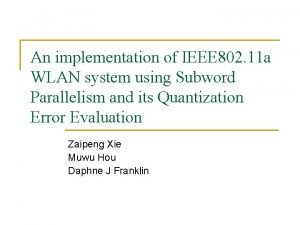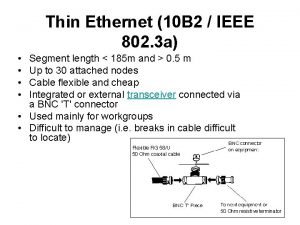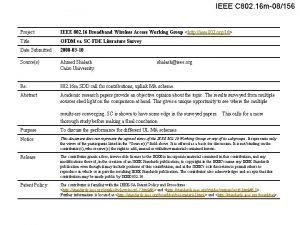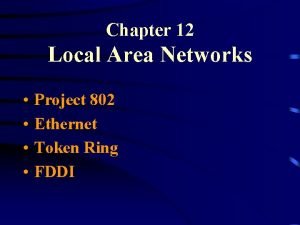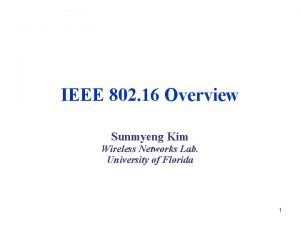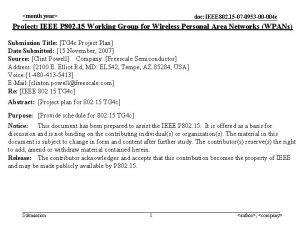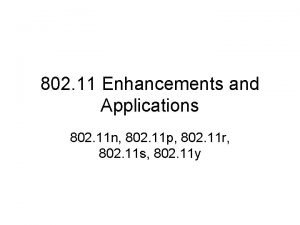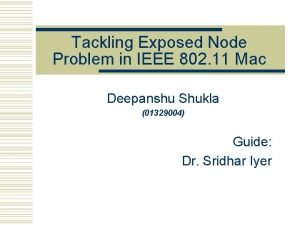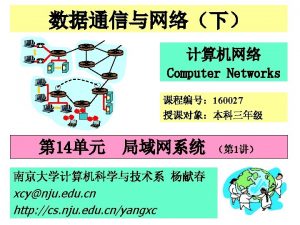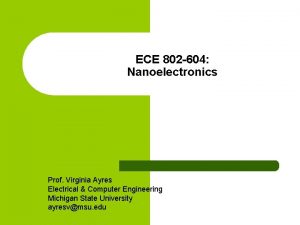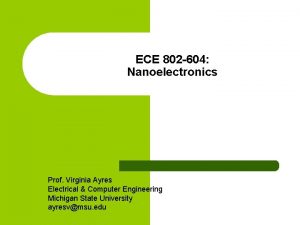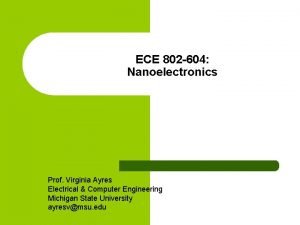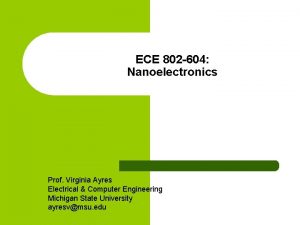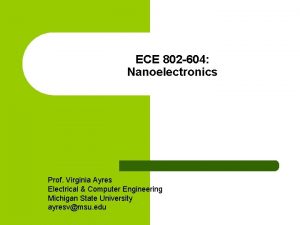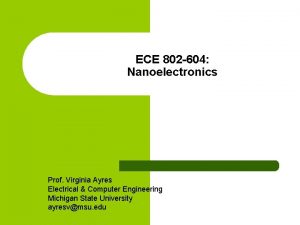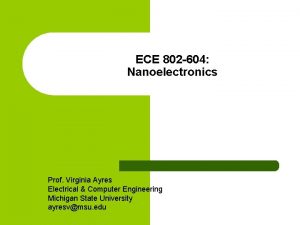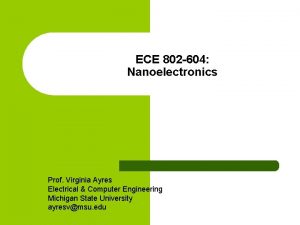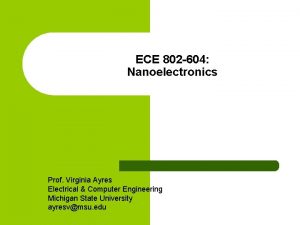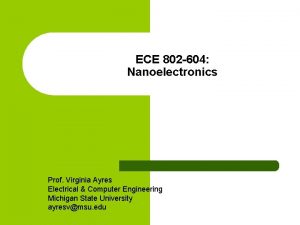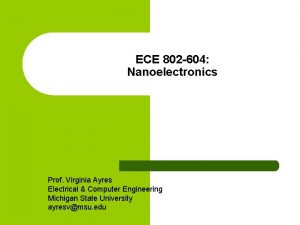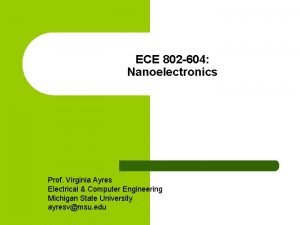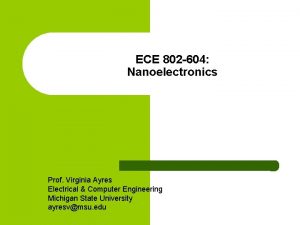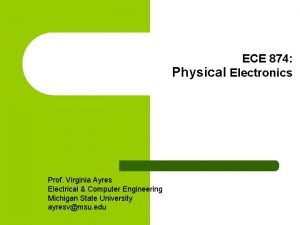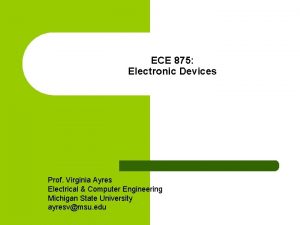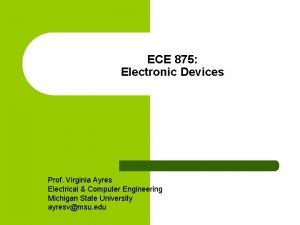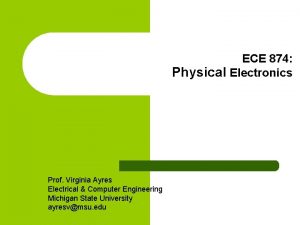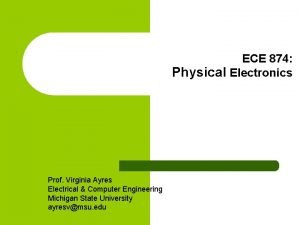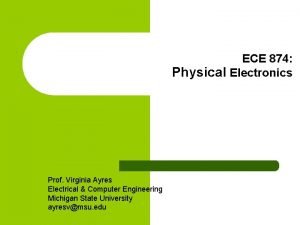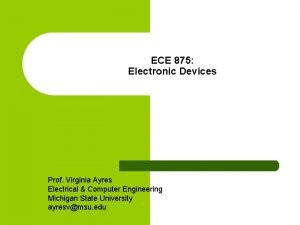ECE 802 604 Nanoelectronics Prof Virginia Ayres Electrical




















































- Slides: 52

ECE 802 -604: Nanoelectronics Prof. Virginia Ayres Electrical & Computer Engineering Michigan State University ayresv@msu. edu

Lecture 14, 15 Oct 13 In Chapters 02 and 03 in Datta: How to correctly measure I = GV Brief discussion: Roukes article Two typo correction HW 02 Pr. 2. 3 Add scattering to Landauer-Buttiker Caveat: when Landauer-Buttiker doesn’t work When it does: Sections 2. 5 and 2. 6: motivation: why: 2. 5: Probes as scatterers especially at high bias/temps Buttiker approach for dealing with incoherent scatterers 2. 6 occupied states as scatterers 3. 1 scattering/S matrix VM Ayres, ECE 802 -604, F 13

Roukes article: VM Ayres, ECE 802 -604, F 13

Roukes article: VM Ayres, ECE 802 -604, F 13

Roukes article: TR possibilities: rebound direct rebound + seems to be direct X B F = q(v x B) = -|e| (v X B) VM Ayres, ECE 802 -604, F 13

Roukes article: TL possibilities: direct rebound F = q(v x B) = -|e| (v X B) VM Ayres, ECE 802 -604, F 13

Roukes article: HW 01 VA Pr. 01: x = 0. 4, here it is x = 0. 3 HW 01 Datta E 1. 2 Find n and m HW 01 Datta E 1. 1 Find lf VM Ayres, ECE 802 -604, F 13

Two typos Pr. 2. 3: Roukes article: TL direct rebound Roukes article: TR rebound direct VM Ayres, ECE 802 -604, F 13

Two typos Pr. 2. 3, marked in magenta: Datta Pr. 2. 3, p. 113: TR X B T 2 1 Datta Pr. 2. 3, p. 113: TL VM Ayres, ECE 802 -604, F 13

Lecture 14, 15 Oct 13 In Chapters 02 and 03 in Datta: How to correctly measure I = GV Brief discussion: Roukes article: HW 02 Pr. 2. 3: Add scattering to Landauer-Buttiker Caveat: when Landauer-Buttiker doesn’t work When it does: Sections 2. 5 and 2. 6: motivation: why: 2. 5: Probes as scatterers especially at high bias/temps Buttiker approach for dealing with incoherent scatterers 3. 1 scattering/S matrix VM Ayres, ECE 802 -604, F 13

Lec 13: In Section 2. 5: 2 -t example: with broadened Fermi f 0 Practical example: Roukes VM Ayres, ECE 802 -604, F 13

Lec 13: i as a function of how much energy E/what channel M the e- is in If T = T’, can get to Landauer-Buttiker but no reason why T should = T’. Especially if energies from probes took e- far from equilibrium. VM Ayres, ECE 802 -604, F 13

Lec 13: Can expect T = T’ at equilibrium. Consider: if energies from probes don’t take e- far from equilibrium: VM Ayres, ECE 802 -604, F 13

Lec 13: New useful G: VM Ayres, ECE 802 -604, F 13

Lec 13: Basically I = G^V = G^ (m 1 -m 2) e that works when probes hotted things up but not too far from equilibrium VM Ayres, ECE 802 -604, F 13

Lec 13: Example: does the figure shown appear to meet the linear (I = G^ V) regime criteria? Criteria is: m 1 -m 2 << k. BT FWHM shown is k. BT Answer: No, they appear to be about the same (red and blue). However, part of FT(E) is low value. Comparing an ‘effective’ m 1 -m 2 (green) maybe it’s OK. VM Ayres, ECE 802 -604, F 13

Lec 13: If T(E) changes rapidly with energy, the “correlation energy” ec is said to be small. 0. 85 T(E) 0. 09 5 e. V 5. 001 e. V E A very minimal change in e- energy and you are getting a different and much worse transmission probability. VM Ayres, ECE 802 -604, F 13

2 -DEG VM Ayres, ECE 802 -604, F 13

Example: in HW 01 Pr. 1. 1 you solved for tf for a 2 -DEG in Ga. As @ 1 K using the graph shown in Figure 1. 3. 2. Estimate the corresponding correlation energy ec VM Ayres, ECE 802 -604, F 13

Estimate the corresponding correlation energy ec Answer: VM Ayres, ECE 802 -604, F 13

Lecture 14, 15 Oct 13 In Chapters 02 and 03 in Datta: How to correctly measure I = GV Brief discussion: Roukes article Two typo correction HW 02 Pr. 2. 3 Add scattering to Landauer-Buttiker Caveat: when Landauer-Buttiker doesn’t work When it does: Sections 2. 5 and 2. 6: motivation: why: 2. 5: Probes as scatterers especially at high bias/temps Buttiker approach for dealing with incoherent scatterers 3. 1 scattering/S matrix VM Ayres, ECE 802 -604, F 13

Lec 10: Scattering: Landauer formula for R for 1 coherent scatterer X: Reflection = resistance VM Ayres, ECE 802 -604, F 13

Lec 10: Coherent scattering means that phases of both transmitted and reflected e - waves are related to the incoming e- wave in a known manner E > barrier height V 0 E < barrier height V 0 VM Ayres, ECE 802 -604, F 13

Lec 10: Transmission probability for 2 scatterers: T => T 12: That’s interesting. That Ratio is additive: Assuming that the scatterers are identical: VM Ayres, ECE 802 -604, F 13

Therefore: Resistance for two coherent scatterers is: VM Ayres, ECE 802 -604, F 13

VM Ayres, ECE 802 -604, F 13

VM Ayres, ECE 802 -604, F 13

VM Ayres, ECE 802 -604, F 13

VM Ayres, ECE 802 -604, F 13

Resistance is due to partially coherent /partially incoherent transmission VM Ayres, ECE 802 -604, F 13

1 Deg, M = 1 m. R m. L X O m X Example: probe VM Ayres, ECE 802 -604, F 13

1 Deg, M = 1 m. R m. L X O m X probe m VM Ayres, ECE 802 -604, F 13

Model the phase destroying impurity as two channels attached to an energy reservoir m VM Ayres, ECE 802 -604, F 13

Influence of the incoherent impurity can be described using a Landauer approach as: VM Ayres, ECE 802 -604, F 13

m. L m. R m VM Ayres, ECE 802 -604, F 13

m. L m. R m VM Ayres, ECE 802 -604, F 13

m. L m. R m VM Ayres, ECE 802 -604, F 13

m. L m. R m VM Ayres, ECE 802 -604, F 13

Landauer-Buttiker treats all “probes” equally: what is going into “probe” 3: m. L m. R m VM Ayres, ECE 802 -604, F 13

Landauer-Buttiker treats all “probes” equally: what is going into “probe” 4: m. L m. R m VM Ayres, ECE 802 -604, F 13

Outline of the solution: Goal: V = IR, solve for R What is V: m. A – m. B What is I: I = I 1 = I 2 VM Ayres, ECE 802 -604, F 13

1 Deg, M = 1 m. R m. L X O m m. A X probe m. B m VM Ayres, ECE 802 -604, F 13

VM Ayres, ECE 802 -604, F 13

VM Ayres, ECE 802 -604, F 13

VM Ayres, ECE 802 -604, F 13

Condition: net current I 3 + I 4 = 0 VM Ayres, ECE 802 -604, F 13

VM Ayres, ECE 802 -604, F 13

Condition: net current I 3 + I 4 = 0 VM Ayres, ECE 802 -604, F 13

Condition: net current I 3 + I 4 = 0 VM Ayres, ECE 802 -604, F 13

VM Ayres, ECE 802 -604, F 13

VM Ayres, ECE 802 -604, F 13

m. L m. R VM Ayres, ECE 802 -604, F 13
 Virginia ayres
Virginia ayres Virginia ayres
Virginia ayres Bridges from 802.x to 802.y
Bridges from 802.x to 802.y Bridges from 802.x to 802.y
Bridges from 802.x to 802.y Nanoelectronics
Nanoelectronics Semiconductor device
Semiconductor device Nanoelectronics
Nanoelectronics The ruler of the land 604
The ruler of the land 604 Power pc 604
Power pc 604 Safari 604
Safari 604 Obstetrics instrument
Obstetrics instrument Ayres
Ayres Poziomy integracji sensorycznej
Poziomy integracji sensorycznej Ayres
Ayres Rusty and the ayers rockettes
Rusty and the ayers rockettes Jean ayres
Jean ayres Ayres locales
Ayres locales Natasha ayres
Natasha ayres Seo northern virginia
Seo northern virginia Ssin-802
Ssin-802 Ethernet 802
Ethernet 802 Geo 802
Geo 802 Bluetooth ieee 802
Bluetooth ieee 802 802 16
802 16 Lan 701
Lan 701 Ieee 802
Ieee 802 Ieee 802 family
Ieee 802 family 09 802 0561
09 802 0561 802 5
802 5 802 15
802 15 802 family
802 family 802 16
802 16 802/11
802/11 802 11 b
802 11 b 802 eap
802 eap Ethernet 802
Ethernet 802 Wlan 802
Wlan 802 802-3-ethernet
802-3-ethernet 802 16
802 16 802 16
802 16 Project 802
Project 802 802 ieee
802 ieee Ssin-802
Ssin-802 Ieee 802 que es
Ieee 802 que es 802 15
802 15 Arquitetura ieee 802
Arquitetura ieee 802 Ieee 802
Ieee 802 507-802-380
507-802-380 Ccna 640-802
Ccna 640-802 802 11 n
802 11 n Geo 802
Geo 802 Exposed node problem
Exposed node problem 802 protocols
802 protocols

